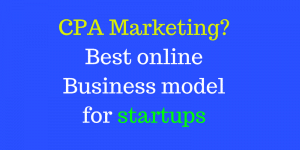
CPA Marketing? Best online Business model for startups
The CPA or Cost per Action is an online business model, where the advertiser pays for each action completed by the visitor. Advertisers pay you when a visitor give their E-mail, Mobile Number, opts for a free trial, or provides relevant information related to their campaign. Cost per Action is one of the most popular methods to make money online through your website, blogs, or newsletters.
This is a bit different from the Adsense program where one gets a commission when a visitor clicks on an ad. The CPA requires specific action. As you can discover more while learning the ins and outs of CPA campaigns.
For example, you may pay $ 1.00 for each email address collected from visitors to your website for a free report subscription. While you could earn $ 50 or more from the same person who buys a product or subscription.
Why CPA Marketing is So Popular?
Cost-per-action marketing is one of the best channels to explore if you are interested in generating an additional stream of income, even if you are new to online business and Internet marketing. Here are just a few reasons why CPA campaigns and opportunities are so compelling:
– You’re paying for results– with CPA, you will only pay for actions that will generate quality leads or sales. Whereas in PPC, you have to pay every time when a user clicks on your affiliates’ links.
– There is no need to make cold calls or mass advertising campaigns that normally require a lot of initial investment.
– Advertisers design their campaigns to produce conversions.
Terms Associated with CPA Marketing
There are certain words and terms are mostly repeated on every network, and it is very important for you to know. So here’s a quick section where you can know about all CPA related terms.
Web traffic: It is the number of users accessing a particular website.
Conversion: It is the achievement of a specific goal of a company within its digital marketing strategy, such as filling out a contact form, buying a product or service, downloading a file, becoming a follower of a social network or the newsletter.
Daily Cap – It is the maximum number of conversions you can bring to an offer daily. Conversions above that number won’t be counted. You can always ask your Manager to raise the daily cap.
CPC (cost-per-click): Only paid when users click and access content. It can vary from a few cents to several euros. Currently, the two most commonly used CPC systems are Google Adwords and Facebook Ads.
CPM (cost per thousand): It is the price of one thousand impressions in a web page. This type of measurement is often used in display campaigns and the advertiser pays simply for their presence, rather than for goals.
CTR (click through rate): It is the ratio that is achieved by dividing the number of clicks and number of impressions and multiplying the result by 100. It tells us if the ad we are showing is relevant to the user or not.
CPL (cost per lead): It is the cost of each record obtained.
CPA (cost per acquisition): It is the price for which you have to get a conversion.
CVR (conversion rate) It is the percentage of users who, after clicking on an ad, end up performing the desired final action (what we call conversion), such as filling in a contact form, buying a product or service, downloading a file, becoming a follower of a social network or the newsletter.
KPI (key performance indicator): It is an indicator to measure specific objectives that you want to achieve in a digital marketing campaign. Each company defines its own according to the type of objectives and campaign it develops. These are indicators that are often used to measure small pre-campaign objectives.
For example, in a campaign where the target is the purchase, a KPI could be the time of permanence of each visit in the web or the number of times that the user accedes to the ‘cart'.
EPC – Stands for Earning Per Click. It is a calculated amount that affiliates will earn per click (to offer page) by promoting a particular offer.
Download/Install: You get paid when someone downloads or installs a piece of software.
Publisher: The person that promotes the offer (you).
AM: Stands for “Affiliate Manager”. Your AM is your go-to person in the network
How to Optimize a Campaign with Paid Traffic
The main purpose of every Online campaign is to increase ROI. If you get stuck on a return on investment you are not getting the most out of your campaign. If you are promoting a CPA offer or selling a product as an affiliate, optimizing your campaign plays an important role in getting the Leads or conversions.
4 steps to optimize your campaign:
- Remove the keywords or URLs that do not bring money or conversions.You must remove your campaign keywords or URLs which are not generating any Leads, conversions or subscriptions.
- Place more landing pages.First, you want a landing page that looks clean and professional. Try with two or more landing pages such that you can know which landing pages or performing well. This is important because we have seen many campaigns with a single landing page remain unsuccessful.
- Rotate several CPA offers.Just like rotating landing pages it is very important to rotate the CPA offers. So that you can catch the users interest.
- Where to include CTA: Discover all the possibilities you have at your disposal to attract more traffic to your landing pages. Find the locations for your CTAs that work best for your target audience. Test, measure and analyze your results to increase the number of leads!

